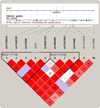Cystic fibrosis transmembrane conductance regulator gene mutation and lung cancer risk
- PMID: 20116881
- PMCID: PMC2895007
- DOI: 10.1016/j.lungcan.2010.01.005
Cystic fibrosis transmembrane conductance regulator gene mutation and lung cancer risk
Abstract
The cystic fibrosis transmembrane conductance regulator (CFTR) holds an important role in retaining lung function, but its association with lung cancer is unclear. A case-control study was conducted to determine the possible associations of the genetic variants in the CFTR gene with lung cancer risk. Genotypes of the most common deletion DeltaF508, one functional SNP, and eight tag SNPs in the CFTR gene were determined in 574 lung cancer patients and 679 controls. A logistic regression model, adjusting for known risk factors, was used to evaluate the association of each variant with lung cancer risk, as confirmation haplotype and sub-haplotype analyses were performed. DeltaF508 deletion and genotypes with minor alleles in one tag SNP, rs10487372, and one functional SNP, rs213950, were inversely associated with lung cancer risk. The results of haplotype and sub-haplotype analyses were consistent with single variant analysis, all pointing to deletion DeltaF508 being the key variant for significant haplotypes and sub-haplotypes. Individuals with 'deletion-T' (DeltaF508/rs10487372) haplotype had a 68% reduced risk for lung cancer compared to common haplotype 'no-deletion-C' (OR=0.32; 95% CI=0.15-0.68; p=0.01). Genetic variations in the CFTR gene might modulate the risk of lung cancer. This study, for the first time, provides evidence of a protective role of the CFTR deletion carrier in the etiology of lung cancer.
Copyright 2010 Elsevier Ireland Ltd. All rights reserved.
Conflict of interest statement
Figures




Similar articles
-
Haplotype analysis of the CFTR gene on normal and mutant CFTR genes.Mutat Res. 2020 May-Dec;821:111708. doi: 10.1016/j.mrfmmm.2020.111708. Epub 2020 May 23. Mutat Res. 2020. PMID: 32563932
-
Cystic fibrosis transmembrane regulator (CFTR) DeltaF508 mutation and 5T allele in patients with chronic pancreatitis and exocrine pancreatic cancer. PANKRAS II Study Group.Gut. 2001 Jan;48(1):70-4. doi: 10.1136/gut.48.1.70. Gut. 2001. PMID: 11115825 Free PMC article.
-
XV-2c and KM.19 haplotype analysis in Chilean patients with cystic fibrosis and unknown CFTR gene mutations.Biol Res. 2007;40(2):223-9. doi: 10.4067/s0716-97602007000200013. Epub 2007 Nov 21. Biol Res. 2007. PMID: 18064359
-
The cradle of the deltaF508 mutation.J Ayub Med Coll Abbottabad. 2008 Oct-Dec;20(4):157-60. J Ayub Med Coll Abbottabad. 2008. PMID: 19999232 Review.
-
Gene SNPs and mutations in clinical genetic testing: haplotype-based testing and analysis.Mutat Res. 2005 Jun 3;573(1-2):195-204. doi: 10.1016/j.mrfmmm.2004.08.018. Mutat Res. 2005. PMID: 15829248 Review.
Cited by
-
CFTR is a potential marker for nasopharyngeal carcinoma prognosis and metastasis.Oncotarget. 2016 Nov 22;7(47):76955-76965. doi: 10.18632/oncotarget.12762. Oncotarget. 2016. PMID: 27769067 Free PMC article.
-
Cystic fibrosis transmembrane conductance regulator-emerging regulator of cancer.Cell Mol Life Sci. 2018 May;75(10):1737-1756. doi: 10.1007/s00018-018-2755-6. Epub 2018 Feb 6. Cell Mol Life Sci. 2018. PMID: 29411041 Free PMC article. Review.
-
Family specific genetic predisposition to breast cancer: results from Tunisian whole exome sequenced breast cancer cases.J Transl Med. 2018 Jun 7;16(1):158. doi: 10.1186/s12967-018-1504-9. J Transl Med. 2018. PMID: 29879995 Free PMC article.
-
Mechanisms of Lung Cancer Development in Cystic Fibrosis Patients: The Role of Inflammation, Oxidative Stress, and Lung Microbiome Dysbiosis.Biomolecules. 2025 Jun 6;15(6):828. doi: 10.3390/biom15060828. Biomolecules. 2025. PMID: 40563468 Free PMC article. Review.
-
MARCH2 regulates autophagy by promoting CFTR ubiquitination and degradation and PIK3CA-AKT-MTOR signaling.Autophagy. 2016 Sep;12(9):1614-30. doi: 10.1080/15548627.2016.1192752. Epub 2016 Jun 16. Autophagy. 2016. PMID: 27308891 Free PMC article.
References
-
- Zielenski J, Tsui LC. Cystic fibrosis: genotypic and phenotypic variations. Annu Rev Genet. 1995;29:777–807. - PubMed
-
- Durno C, Corey M, Zielenski J, Tullis E, Tsui LC, Durie P. Genotype and phenotype correlations in patients with cystic fibrosis and pancreatitis. Gastroenterology. 2002;123:1857–1864. - PubMed
-
- Neglia JP, FitzSimmons SC, Maisonneuve P, Schoni MH, Schoni-Affolter F, Corey M, et al. The risk of cancer among patients with cystic fibrosis. Cystic Fibrosis and Cancer Study Group. N Engl J Med. 1995;332:494–499. - PubMed
Publication types
MeSH terms
Substances
Grants and funding
LinkOut - more resources
Full Text Sources
Other Literature Sources
Medical

